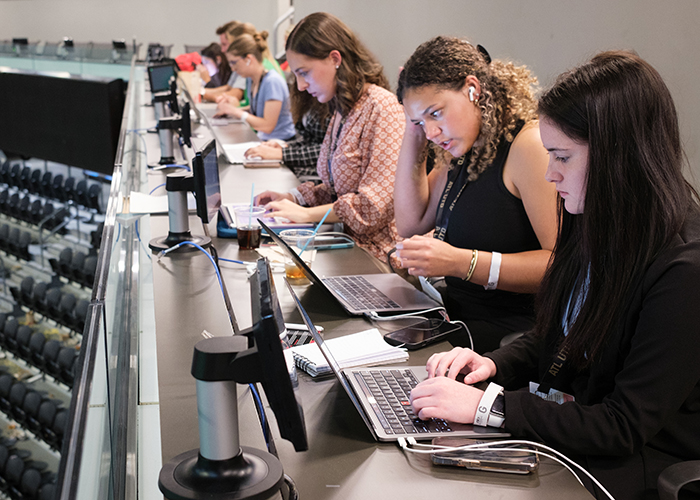Sports Media students prepare for Women’s World Cup

Sports Media students prepare for Women’s World Cup
Covering the FIFA Women’s World Cup in Australia would be a dream opportunity for most college journalists. For a group of University of Georgia sports media and visual journalism students, it’s reality.
Seventeen students, accompanied by three faculty members, will cover World Cup group-play matches in July and early August for The Associated Press. AP will distribute the students’ work globally. The partnership is similar to a 2016 initiative that saw student coverage of the Summer Paralympics in Rio de Janeiro published by outlets such as The New York Times and The Guardian.
For Luke Winstel, an opportunity such as this is one of the main reasons he transferred to UGA.
“I’ve always had dreams of one day being in one of these major publications,” Winstel said. “This might be the first really big byline for me. It’s also a chance to showcase what I’ve learned from my teachers and achieve some of those goals and get that first taste of some of that success that I’ve been hoping for.”
Australia and New Zealand are co-hosting the 2023 Women’s World Cup. Sixteen teams, including 2020 Olympic champion Canada and 2022 European champion England, will be based in Australia for group play. The students will produce match coverage on deadline, including photos and game recaps, as well as breaking-news reports and off-day features.
The students will spend almost a month based in one of three Australian cities: Sydney, Brisbane or Melbourne. A Grady College journalism instructor will be stationed in each city to help the students. Faculty going include Vicki Michaelis, the John Huland Carmical Chair in Sports Journalism & Society; Mark Johnson, senior lecturer in journalism; and Carlo Finlay, academic professional and assistant director of the Carmical Sports Media Institute.
Earning the Assignment
More than 50 students auditioned to be part of the coverage team last fall. They each covered a Georgia Gwinnett College soccer match, submitting photos or a written game story within three hours of the match ending. Panels comprised of professional journalists and faculty members rated the entries, from which the students’ names had been stripped to ensure objectivity.
While knowledge of soccer was not required, several students going on the trip grew up playing soccer, including Cassidy Hettesheimer, who also has covered two National Women’s Soccer League championship games as a freelancer. Hettesheimer “even petitioned my family to change our summer travels to Canada to go to the 2015 Women’s World Cup.”
Funding from the Carmical Sports Media Institute is helping offset the students’ cost for the trip.
“Coming into college,” Hettesheimer said, “I had set a goal, that felt far-fetched, of attending or working at the 2023 Women’s World Cup. The support of the Sports Media Institute made my dreams that much more achievable and structured, and so I’m super excited.”

Preparation is key
Preparation is key for the students. In April, they gained some experience covering soccer matches at local high schools. The students were required to take a Topics in Sports Media course taught by Welch Suggs, which focused on the evolution of women’s sports globally, and soccer in particular. For a class assignment, the students attended an Atlanta United match as a credentialed journalists to give them experience making photographs, writing deadline game stories and conducting post-game interviews in a big-match atmosphere.
Canon has lent the program cameras and lenses to take to Australia and sent a technical representative to campus to teach the students some of the finer nuances of the sophisticated equipment.
Photojournalism student Victoria Adkins looks forward to becoming faster at captioning photos and understanding Canon equipment better.
“I’m excited to meet new people and see what connections I can make, because I want to get into sports photography after I graduate,” Adkins said.
Another student, Savannah Hernandez, traveled with Professor Michaelis in February to cover the SheBelieves Cup in Nashville, where national teams from Brazil, Canada, Japan and the USA competed. Hernandez reported a story there about Brazil’s star player, Marta, which was distributed by the AP.
“It was an amazing experience,” Hernandez said of the one-on-one opportunity to learn from Michaelis. “It was high-stress environment, but without a lot of liability since I didn’t have to file a story immediately. I was able to get a sense of what the professional environment was like and the challenges presented with that to work through kinks.”
Another way they have immersed themselves in the soccer culture is by playing the FIFA World Cup video game. Through the video game, Winstel has become familiar with the members of the Australian team, to which he is assigned.
“I can watch highlights on YouTube and then supplement that with the video game and the reading and you’ve got all these different things that exercise your brain,” Winstel said.

Setting Expectations
Winstel appreciates that he won’t have to go through a translator for interviews, but he knows covering the home team will be competitive since there will be a lot of local media demands for interviews.
All the students have high expectations to improve their skills on an international sports stage.
“I want to grow in my confidence as a journalist,” Hernandez concluded. “I’m sure I will be put in situations where I have to put myself out there more, so just getting out of comfort zone and getting in reps of writing will help me reach my goal of becoming a better writer every day.”
Winstel recalls that when he was growing up his mother, who is an artist, had one of her drawings featured in the Wall Street Journal, which now hangs on the wall at home.
“This is a chance for me to have that kind of moment that could be there forever…that’s what I look forward to.”